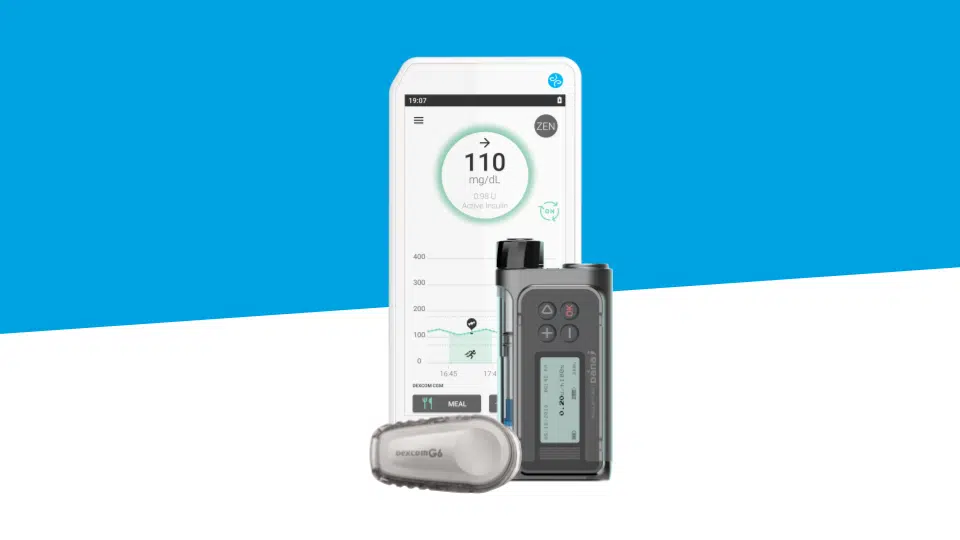
Type 1 diabetes and eye complications: diabetic retinopathy
One of the most common complications of Type 1 diabetes regards the eyes. The term retinopathy is used because it is the retina that is most affected. But you can still have sharp eyes when you’re living with Type 1 diabetes!
Diabetic retinopathy causes
Far from being inevitable, the risk of eye damage obviously depends on how long you have had diabetes and how severe the blood sugar imbalance is. So diabetic retinopathy is rare before the age of 18. Diabetes management is another crucial factor in the development of this complication. It is now known that poor control of blood sugar levels in childhood¹ can cause more severe retinopathy later on, even if levels were better controlled in adulthood. Yet another reason to carefully monitor children’s blood sugar levels.
However, all people are not equal when it comes to the risks of this complication. Some people might develop diabetic retinopathy fairly quickly, possibly aggravated by other conditions, such as pregnancy in women, or a sudden lowering of blood sugar levels. Others may have Type 1 diabetes for many years without any impact on their eyes. Regardless of your situation, the general consensus is that good blood sugar control is crucial to limit the risks.
Progression of retinopathy
The main parts of the eye that are typically damaged are the small blood vessels in the retina (microangiopathy) and the ocular nerves. These microangiopathies are a direct result of glucotoxicity (chronic hyperglycemia).
A variety of abnormalities can develop in the eye. The structure of the small blood vessels in the eye is modified by chronic hyperglycemia. Weakened areas gradually develop in the vessels; these are known as microaneurysms and cause microhemorrhages. As time goes on, the blood supply is blocked to certain areas of the retina. This causes ischemia.
To counter this ischemia, new blood vessels form: this is known as neo-vascularization. These newly formed vessels are much weaker than normal blood vessels. Without treatment, they can cause serious complications, such as hemorrhaging into the vitreous humor of the eye. If the leaked blood is not absorbed on its own, it can cause reduced vision and require surgery (vitrectomy). If fibrosis develops, the resulting traction on the retina can lead to retinal detachment.
Diabetic retinopathy is described as non-proliferative or proliferative, depending on whether or not new vessels are growing, with different stages of severity and, consequently different risks of complications, which may even include blindness.
Later retinopathy symptoms
Fortunately, Type 1 diabetes-related eye damage is much rarer nowadays than it used to be. But vision loss is still possible, especially in the event of macular edema (swelling of the macula, which is the area of the retina most important for vision). To avoid this, it is important to act quickly because there are preventive and curative treatments.
Effective treatments if initiated early
The first factor is always good control of blood sugar levels. There is a direct link between HbA1c levels and retinopathy, especially in young patients. So good blood sugar control is crucial to prevent the progression of retinopathy if it is present. However, in patients with very advanced retinopathy or poorly controlled diabetes, blood sugar levels should be improved gradually, to avoid making the retinopathy worse. It is also essential to avoid factors that could aggravate diabetic retinopathy, such as high blood pressure or smoking.
Treatments exist for every stage of diabetic retinopathy, but the earlier they are begun, the more effective they are. Laser photocoagulation is one of the most effective treatments to destroy new blood vessels. In the event of a hemorrhage, laser treatment is no longer possible and more complex surgery is required. To avoid this and look after your eyesight, regular check-ups are essential.
What type of regular tests are required to limit complications?²
- Ophthalmoscopy from the time of diabetes diagnosis (in children, first exam at the age of 10)
- Annual ophthalmoscopy, then first angiography on detection of the first signs of diabetic retinopathy (and possibly routinely after diabetes has been present for 5 years)
¹Mary White, Matthew A Sabin, Costan G Magnussen, Michele A O’Connell, Peter G Colman and Fergus Cameron. Long term risk of severe retinopathy in childhood-onset type 1 diabetes: a data linkage study. Med J Aust 2017; 206 (9): 398-401. || doi: 10.5694/mja16.00712
²https://www.medicalnewstoday.com/articles/183417.php







